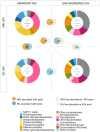Large Enrichment of Anthropogenic Organic Matter Degrading Bacteria in the Sea-Surface Microlayer at Coastal Livingston Island (Antarctica)
- PMID: 33013806
- PMCID: PMC7516020
- DOI: 10.3389/fmicb.2020.571983
Large Enrichment of Anthropogenic Organic Matter Degrading Bacteria in the Sea-Surface Microlayer at Coastal Livingston Island (Antarctica)
Abstract
The composition of bacteria inhabiting the sea-surface microlayer (SML) is poorly characterized globally and yet undescribed for the Southern Ocean, despite their relevance for the biogeochemistry of the surface ocean. We report the abundances and diversity of bacteria inhabiting the SML and the subsurface waters (SSL) determined from a unique sample set from a polar coastal ecosystem (Livingston Island, Antarctica). From early to late austral summer (January-March 2018), we consistently found a higher abundance of bacteria in the SML than in the SSL. The SML was enriched in some Gammaproteobacteria genus such as Pseudoalteromonas, Pseudomonas, and Colwellia, known to degrade a wide range of semivolatile, hydrophobic, and surfactant-like organic pollutants. Hydrocarbons and other synthetic chemicals including surfactants, such as perfluoroalkyl substances (PFAS), reach remote marine environments by atmospheric transport and deposition and by oceanic currents, and are known to accumulate in the SML. Relative abundances of specific SML-enriched bacterial groups were significantly correlated to concentrations of PFASs, taken as a proxy of hydrophobic anthropogenic pollutants present in the SML and its stability. Our observations provide evidence for an important pollutant-bacteria interaction in the marine SML. Given that pollutant emissions have increased during the Anthropocene, our results point to the need to assess chemical pollution as a factor modulating marine microbiomes in the contemporaneous and future oceans.
Keywords: ADOC; amplicon sequencing; bacterioneuston; microbial communities; organic pollutants; sea-surface microlayer; surfactants.
Copyright © 2020 Martinez-Varela, Casas, Piña, Dachs and Vila-Costa.
Figures






Similar articles
-
Polycyclic Aromatic Hydrocarbon Degradation in the Sea-Surface Microlayer at Coastal Antarctica.Front Microbiol. 2022 Jul 14;13:907265. doi: 10.3389/fmicb.2022.907265. eCollection 2022. Front Microbiol. 2022. PMID: 35910648 Free PMC article.
-
Enrichment of perfluoroalkyl substances in the sea-surface microlayer and sea-spray aerosols in the Southern Ocean.Environ Pollut. 2020 Dec;267:115512. doi: 10.1016/j.envpol.2020.115512. Epub 2020 Aug 27. Environ Pollut. 2020. PMID: 32892018
-
Enrichment of organic pollutants in the sea surface microlayer (SML) at Terra Nova Bay, Antarctica: influence of SML on superficial snow composition.J Environ Monit. 2005 Dec;7(12):1305-12. doi: 10.1039/b507321a. Epub 2005 Oct 19. J Environ Monit. 2005. PMID: 16307088
-
A review of pollutants in the sea-surface microlayer (SML): a unique habitat for marine organisms.Mar Pollut Bull. 2004 Jun;48(11-12):1016-30. doi: 10.1016/j.marpolbul.2004.03.016. Mar Pollut Bull. 2004. PMID: 15172807 Review.
-
Assessment on the distributions and exchange of anionic surfactants in the coastal environment of Peninsular Malaysia: A review.Environ Sci Pollut Res Int. 2022 Mar;29(11):15380-15390. doi: 10.1007/s11356-021-18395-1. Epub 2022 Jan 6. Environ Sci Pollut Res Int. 2022. PMID: 34988826 Review.
Cited by
-
Polycyclic Aromatic Hydrocarbon Degradation in the Sea-Surface Microlayer at Coastal Antarctica.Front Microbiol. 2022 Jul 14;13:907265. doi: 10.3389/fmicb.2022.907265. eCollection 2022. Front Microbiol. 2022. PMID: 35910648 Free PMC article.
-
Snow-Dependent Biogeochemical Cycling of Polycyclic Aromatic Hydrocarbons at Coastal Antarctica.Environ Sci Technol. 2023 Jan 31;57(4):1625-1636. doi: 10.1021/acs.est.2c05583. Epub 2023 Jan 19. Environ Sci Technol. 2023. PMID: 36655903 Free PMC article.
-
Diesel in Antarctica and a Bibliometric Study on Its Indigenous Microorganisms as Remediation Agent.Int J Environ Res Public Health. 2021 Feb 5;18(4):1512. doi: 10.3390/ijerph18041512. Int J Environ Res Public Health. 2021. PMID: 33562609 Free PMC article. Review.
-
Land Cover and Seasonal Variations Shape Soil Microbial Communities and Nutrient Cycling in Madagascar Tropical Forests.Microb Ecol. 2025 Jun 4;88(1):60. doi: 10.1007/s00248-025-02561-w. Microb Ecol. 2025. PMID: 40467851 Free PMC article.
-
Study of the Bacterial, Fungal, and Archaeal Communities Structures near the Bulgarian Antarctic Research Base "St. Kliment Ohridski" on Livingston Island, Antarctica.Life (Basel). 2024 Feb 19;14(2):278. doi: 10.3390/life14020278. Life (Basel). 2024. PMID: 38398787 Free PMC article.
References
-
- Aller J. Y., Kuznetsova M. R., Jahns C. J., Kemp P. F. (2005). The sea surface microlayer as a source of viral and bacterial enrichment in marine aerosols. J. Aerosol Sci. 36 801–812. 10.1016/j.jaerosci.2004.10.012 - DOI
-
- Alonso-Sáez L., Gasol J. M., Lefort T., Hofer J., Sommaruga R. (2006). Effect of natural sunlight on bacterial activity and differential sensitivity of natural bacterioplankton groups in Northwestern Mediterranean coastal waters. Appl. Environ. Microbiol. 72 5806–5813. 10.1128/aem.00597-06 - DOI - PMC - PubMed
LinkOut - more resources
Full Text Sources

